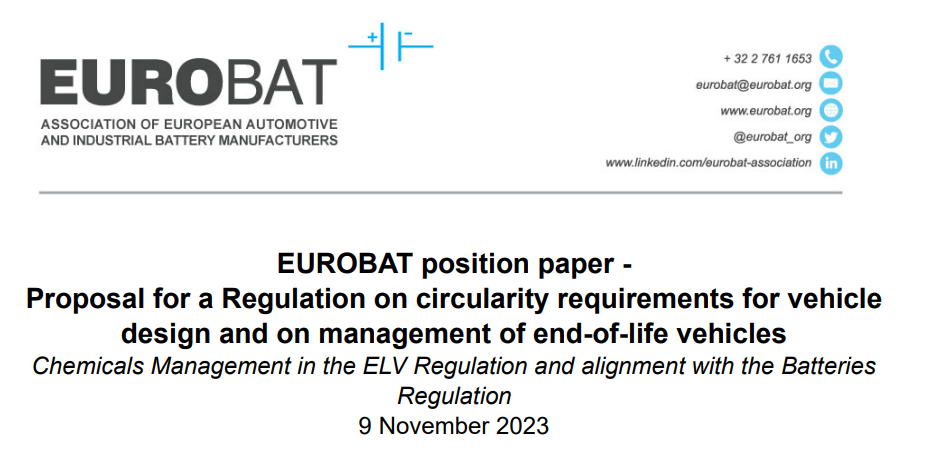EUROBAT Position Paper – Proposal for a Regulation on circularity requirements for vehicle design and on management of end-of-life vehicles
 There are 280 million vehicles on the roads of Europe and 1.5 billion road vehicles globally. In all these vehicles, batteries of various chemistries fulfill different functions. They fulfil starting, lighting and ignition purposes, they have auxiliary functions or serve as traction batteries in electric vehicles. Batteries are hence a key component of every vehicle.
There are 280 million vehicles on the roads of Europe and 1.5 billion road vehicles globally. In all these vehicles, batteries of various chemistries fulfill different functions. They fulfil starting, lighting and ignition purposes, they have auxiliary functions or serve as traction batteries in electric vehicles. Batteries are hence a key component of every vehicle.
An up-to-date end-of-life vehicles policy, that is at the same time aligned with the other pieces of the EU battery policy, is critical to the European battery industry. Therefore, we appreciate the possibility to comment on the European Commission’s proposal for a Regulation on circularity requirements for vehicles design and on management of end-of-life vehicles.
We welcome the increased ambition to address the issue of when a vehicle has reached its end-of-life stage or not. Vehicles that are exported for second-hand use are usually exported together with their battery. Additional legal clarity on the end-of-life status of a vehicle will ensure that only vehicles with a product status and not waste will be exported outside the OECD. Ensuring uniform and environmentally sound end-of-life treatment of batteries from vehicles is essential.
As EUROBAT, we are, however, disappointed with the incomplete alignment between the proposed Regulation on circularity requirements for vehicle design and on management and the new Batteries Regulation.
We request that:
1. Restrictions of battery substances to be removed entirely from the scope of the proposed Regulation on circularity requirements for vehicle design and on management of end-of-life vehicles. This issue is already addressed through Article 6 of the new Battery Regulation.
2. The next scheduled lead battery exemption review scheduled for 2025 under the ELV Directive annex II.5b(i) (or future Regulation on circularity requirements for vehicle design and on management of end-of-life vehicles annex III.5(b)(i)) should be paused and incorporated into the comprehensive report required under Article 6(5) of the Batteries Regulation (EU 2023/1542) being undertaken by the Commission and European Chemicals Agency (ECHA) on substances of concern present in batteries or used in their manufacture.
Read the full position paper here.
